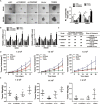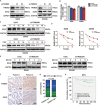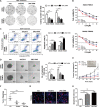TRIM25 regulates oxaliplatin resistance in colorectal cancer by promoting EZH2 stability
- PMID: 33966039
- PMCID: PMC8106682
- DOI: 10.1038/s41419-021-03734-4
TRIM25 regulates oxaliplatin resistance in colorectal cancer by promoting EZH2 stability
Abstract
Resistance to chemotherapy remains the major cause of treatment failure in patients with colorectal cancer (CRC). Here, we identified TRIM25 as an epigenetic regulator of oxaliplatin (OXA) resistance in CRC. The level of TRIM25 in OXA-resistant patients who experienced recurrence during the follow-up period was significantly higher than in those who had no recurrence. Patients with high expression of TRIM25 had a significantly higher recurrence rate and worse disease-free survival than those with low TRIM25 expression. Downregulation of TRIM25 dramatically inhibited, while overexpression of TRIM25 increased, CRC cell survival after OXA treatment. In addition, TRIM25 promoted the stem cell properties of CRC cells both in vitro and in vivo. Importantly, we demonstrated that TRIM25 inhibited the binding of E3 ubiquitin ligase TRAF6 to EZH2, thus stabilizing and upregulating EZH2, and promoting OXA resistance. Our study contributes to a better understanding of OXA resistance and indicates that inhibitors against TRIM25 might be an excellent strategy for CRC management in clinical practice.
Conflict of interest statement
The authors declare no competing interests.
Figures







Similar articles
-
A KLF4/PiHL/EZH2/HMGA2 regulatory axis and its function in promoting oxaliplatin-resistance of colorectal cancer.Cell Death Dis. 2021 May 13;12(5):485. doi: 10.1038/s41419-021-03753-1. Cell Death Dis. 2021. PMID: 33986248 Free PMC article.
-
Suppression MGP inhibits tumor proliferation and reverses oxaliplatin resistance in colorectal cancer.Biochem Pharmacol. 2021 Jul;189:114390. doi: 10.1016/j.bcp.2020.114390. Epub 2020 Dec 22. Biochem Pharmacol. 2021. PMID: 33359068
-
Identification of TRIM25 as a Negative Regulator of Caspase-2 Expression Reveals a Novel Target for Sensitizing Colon Carcinoma Cells to Intrinsic Apoptosis.Cells. 2019 Dec 12;8(12):1622. doi: 10.3390/cells8121622. Cells. 2019. PMID: 31842382 Free PMC article.
-
Long non-coding RNAs: Key regulators in oxaliplatin resistance of colorectal cancer.Biomed Pharmacother. 2020 Aug;128:110329. doi: 10.1016/j.biopha.2020.110329. Epub 2020 Jun 2. Biomed Pharmacother. 2020. PMID: 32502843 Review.
-
The role of Trim25 in development, disease and RNA metabolism.Biochem Soc Trans. 2016 Aug 15;44(4):1045-50. doi: 10.1042/BST20160077. Biochem Soc Trans. 2016. PMID: 27528750 Review.
Cited by
-
Exploration of the ubiquitination-related molecular classification and signature to predict the survival and immune microenvironment in colon cancer.Front Genet. 2024 Aug 29;15:1292249. doi: 10.3389/fgene.2024.1292249. eCollection 2024. Front Genet. 2024. PMID: 39268080 Free PMC article.
-
TRIM25 promotes temozolomide resistance in glioma by regulating oxidative stress and ferroptotic cell death via the ubiquitination of keap1.Oncogene. 2023 Jun;42(26):2103-2112. doi: 10.1038/s41388-023-02717-3. Epub 2023 May 15. Oncogene. 2023. PMID: 37188737
-
Therapeutic targeting potential of the protein lysine and arginine methyltransferases to reverse cancer chemoresistance.Front Mol Biosci. 2024 Dec 5;11:1455415. doi: 10.3389/fmolb.2024.1455415. eCollection 2024. Front Mol Biosci. 2024. PMID: 39703687 Free PMC article. Review.
-
EZH2 Inhibition and Cisplatin as a Combination Anticancer Therapy: An Overview of Preclinical Studies.Cancers (Basel). 2022 Sep 29;14(19):4761. doi: 10.3390/cancers14194761. Cancers (Basel). 2022. PMID: 36230683 Free PMC article. Review.
-
Mechanisms and Strategies to Overcome Drug Resistance in Colorectal Cancer.Int J Mol Sci. 2025 Feb 25;26(5):1988. doi: 10.3390/ijms26051988. Int J Mol Sci. 2025. PMID: 40076613 Free PMC article. Review.
References
Publication types
MeSH terms
Substances
LinkOut - more resources
Full Text Sources
Other Literature Sources
Medical

